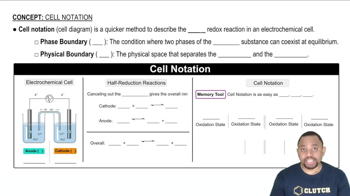Cell Notation definitions Flashcards
 Back
BackCell Notation definitions
1/15
Terms in this set (15)
- Cell NotationA shorthand method to represent the redox reaction in an electrochemical cell using phase and physical boundaries.
- Phase BoundaryA single line in cell notation indicating where two phases of the same substance coexist at equilibrium.
- Physical BoundaryTwo solid lines in cell notation representing the separation between the anode and cathode.
- AnodeThe electrode where oxidation occurs, losing electrons, and is negatively charged in a galvanic cell.
- CathodeThe electrode where reduction occurs, gaining electrons, and is positively charged in a galvanic cell.
- OxidationA process at the anode where electrons are lost, resulting in an increase in oxidation state.
- ReductionA process at the cathode where electrons are gained, resulting in a decrease in oxidation state.
- Galvanic CellA spontaneous electrochemical cell where chemical energy is converted into electrical energy.
- Voltaic CellAnother term for a galvanic cell, where spontaneous redox reactions generate electricity.
- Half-ReactionA part of the redox reaction showing either oxidation or reduction, used to balance the overall reaction.
- ElectrodeA conductor through which electrons enter or leave the electrochemical cell, such as anode or cathode.
- Cu 2+Copper ion with a 2+ charge, involved in reduction at the cathode in the given cell example.
- Cr 2+Chromium ion with a 2+ charge, involved in oxidation at the anode in the given cell example.
- Redox ReactionA chemical reaction involving the transfer of electrons between two species, comprising oxidation and reduction.
- IntermediatesSpecies that appear in the steps of a reaction mechanism but not in the overall balanced equation.


